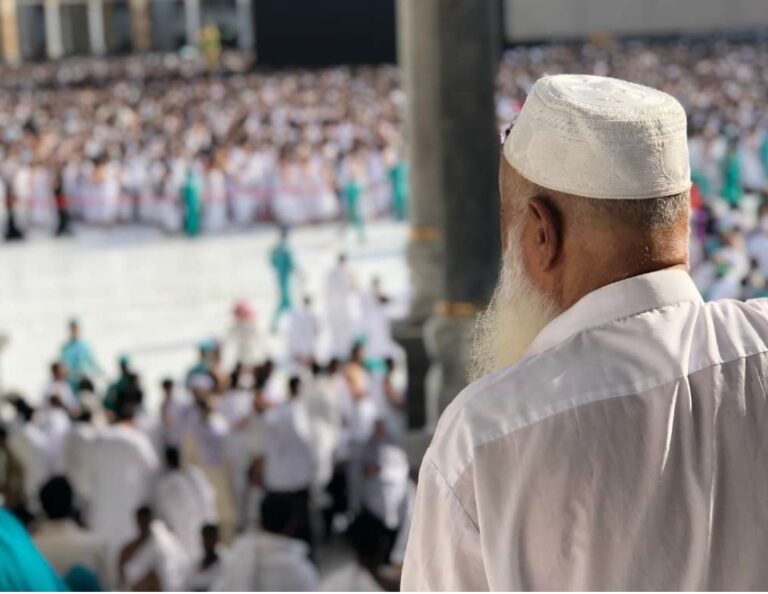Saudi Arabia is a special place for Muslims. It’s where Islam started. A long time ago, in the seventh century, Prophet Muhammad got the Holy Quran from God in this land. Two very important cities, Mecca and Medina, are here. They are the holiest places in Islam. Saudi Arabia is like the heart of the Muslim faith. It helps shape how Muslims pray, live, and think all over the world.
Makkah: Birthplace and Source of Revelation
Mecca is where Prophet Muhammad was born. When he was 40, God sent him the first words of the Quran. That’s when he became a prophet. Mecca is super important because it’s the holiest city for Muslims. Every day, Muslims pray facing a special building in Mecca called the Kaaba.
Lots of Muslims travel to Saudi Arabia to visit Mecca. It’s part of being a Muslim, like one of the five important rules they follow. Mecca is also where Muslims go for a big trip called Hajj. Every Muslim who is healthy and has enough money should try to go to Hajj once in their life. It’s a time to pray and feel close to God.
Why Is Mecca Special?
- Prophet Muhammad was born there.
- The Quran started in Mecca.
- The Kaaba is in Mecca, and Muslims pray toward it.
Medina: City of Prophet and Model for Islamic Governance
A long time ago, in the year 622, Prophet Muhammad moved from Mecca to Medina. This move is called the Hijra. In Medina, he started the first Muslim community. He was the leader for religion, fighting, and making rules. He wrote a special paper called the Constitution of Medina. It made sure everyone was treated fairly, even people who weren’t Muslims.
Medina has a big mosque called Masjid al-Nabawi, or the Prophet’s Mosque. It’s where Prophet Muhammad is buried, so it’s the second holiest place in Islam. Muslims visit Medina to pray and feel peaceful. The city shows how Muslims can live together with fairness and kindness.
What Makes Medina Important?
- It’s where the first Muslim community began.
- The Prophet’s Mosque is there.
- The Constitution of Medina taught fairness.
Unification and Expansion of Islam among Arab Tribes
After Prophet Muhammad died in 632, all the tribes in Saudi Arabia came together as Muslims. Medina was the main place where this happened. From Medina, Islam spread to faraway places like North Africa and Persia. Saudi Arabia was like the starting point for Islam to grow big.
Even when Islam went to other places, Mecca and Medina stayed super important. They are like the home of Islam. People never forgot them, and they kept being the center of the faith.
Religious Movements: Hanbalism and Wahhabism
Saudi Arabia has some special ways of following Islam. One is called Hanbalism. A man named Imam Ahmad ibn Hanbal started it a long time ago. It says to follow the Quran and Prophet Muhammad’s teachings very closely.
Another way is called Wahhabism. It started in the 1700s with a man named Muhammad ibn Abd al-Wahhab. He wanted to make Islam simple and pure. The Al Saud family, who rule Saudi Arabia, helped spread Wahhabism. It changed how people pray in Saudi Arabia and other places.
Hanbalism vs. Wahhabism
| What It’s About | Hanbalism | Wahhabism |
|---|---|---|
| Who Started It | Imam Ahmad ibn Hanbal | Muhammad ibn Abd al-Wahhab |
| When It Started | Long ago (8th–9th century) | 1700s |
| What It Teaches | Follow Quran and Prophet closely | Make Islam simple and pure |
| How It Helped | One of four Sunni ways | Changed Saudi Arabia’s Islam |
Hajj as a Means to Unify Global Islamic Unity
Hajj is a big trip to Mecca that Muslims do. It’s not just praying—it shows how all Muslims are like one big family. Every year, millions of people from all over the world go to Mecca for Umrah and Hajj. They wear the same white clothes and do the same things, like walking around the Kaaba. This makes everyone feel equal.
Saudi Arabia makes sure Hajj goes well. They help all the people who come to pray. It’s like a big party where Muslims from everywhere feel close to each other and to God.
Example: Picture people from 100 countries standing together, all wearing white and praying. That’s what Hajj feels like!
Islamic Education and Religious Institutions
Saudi Arabia has schools that teach about Islam. Two big ones are the Islamic University of Medina and Umm Al-Qura University in Mecca. These schools help students learn about the Quran, Prophet Muhammad, and Islamic rules. Students come from all over the world. When they finish, they become teachers or leaders in their own countries.
These schools help keep Islam strong. They teach people how to share the faith with others. Saudi Arabia spends a lot to make sure these schools are great.
Famous Islamic Schools:
- Islamic University of Medina: Teaches people to be imams or scholars.
- Umm Al-Qura University: Teaches about Islam and other subjects.
Sacred Architecture and Islamic Heritage
Mecca and Medina have beautiful buildings. The Kaaba in Mecca is a special cube-shaped building that Muslims pray toward. The Prophet’s Mosque in Medina has a green dome and tall towers called minarets. These buildings have pretty designs that make people feel calm and close to God.
Saudi Arabia takes care of these places. They make them bigger so more people can visit, but they keep them special. These buildings show the beauty and history of Islam.
Why These Buildings Are Cool:
- They make Muslims feel connected to their faith.
- They have amazing designs, like patterns and towers.
- They are part of Islam’s history.
Saudi Islam Has a Cultural and Societal Impact
Islam is a big part of life in Saudi Arabia. It’s in how families act, how people celebrate holidays like Eid al-Fitr and Eid al-Adha, and even how they dress. Muslims in Saudi Arabia are kind and share with others because Islam teaches them to be generous.
You can see Islam in books, TV, and even when Saudi Arabia trades with other countries. For example, during Eid, families eat together and give gifts. This shows how Islam makes Saudi Arabia special.
Current Challenges to Religious Reform
Saudi Arabia is changing with a plan called Vision 2030. They want to keep Islam strong but also make things modern. They’re teaching women new subjects, like technology, and talking with people from other religions. This helps Islam fit with today’s world.
For example, women can now study things they couldn’t before. Saudi Arabia also keeps Mecca and Medina safe and special. These changes show they care about both the past and the future.
Conclusion: At the Heart of Islamic History
Saudi Arabia is more than a country. It’s where Islam began and where its holiest places are. From the Quran’s first words to the big Hajj trip, Saudi Arabia helps Muslims feel connected. In 2025, it still leads with its schools, buildings, and new ideas. This land is the past, present, and future of Islam, bringing Muslims together all over the world.
Disclaimer: This article is for general information only and describes Saudi Arabia’s role in Islam as of October 18, 2025. It is not linked to any official group in Saudi Arabia. The author and publisher are not responsible for any errors, outdated details, or misuse of this content. For accurate information, check official or scholarly sources. This article follows Google’s content rules and does not violate any copyrights.





